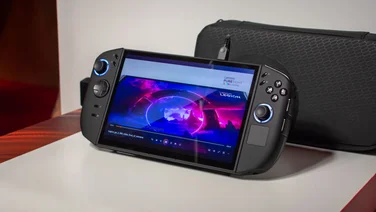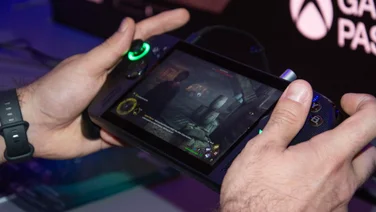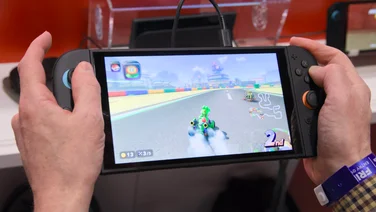To help us provide you with free impartial advice, we may earn a commission if you buy through links on our site. Learn more

The Nintendo 2DS was, in some ways, an expected arrival for Nintendo’s popular 3DS handheld. Nintendo threw everyone a curveball with its arrival as nobody expected Nintendo to strip out the 3DS’s headline feature and clamshell design for this mid-generation refresh.
Yes that’s right, as its name implies, the Nintendo 2DS eschews the 3DS’ 3D technology in favour of a more traditional handheld gaming experience. Apart from its wedge design, this is as true a DS Lite successor as you’ll find, and it’s perfect for younger kids.
Since its 2013 release, Nintendo has updated the 2DS with the New Nintendo 2DS XL. Not only does this larger-screened 2DS handheld feature the same clamshell design as it’s 3DS counterparts, it’s crammed with all the technology found in the more powerful New 3DS and New 3DS XL.
Nintendo 2DS review: Design
The loss of the clamshell hinge will come as a blow to fans of the original 3DS design, but its new wedge shape is surprisingly comfortable to use. The bottom corners sit snugly in the centre of your palms and the Circle Pad and ABXY buttons are perfectly positioned to lie directly underneath your thumb. Likewise, the trigger buttons are now much easier to reach than before as they lie more naturally underneath your index fingers compared to the cramp-inducing shape of the original 3DS.
Admittedly, the matt plastic chassis is a far cry from the sleek contours of Nintendo’s previous budget handheld, the gorgeous DS Lite, but it’s far more suited to being thrown around in a backpack than other members of the 3DS family. I always thought the 3DS was a little fragile to carry around without a case, but I have no such qualms about the 2DS’s tough exterior.
Nintendo 2DS review: Screens
On the thread of durability, the 2DS’ top screen is protected by a tough plastic cover that sits flush to the console. The only vulnerable part of the 2DS then is the lower touchscreen. This has to be left exposed in order to use it, but special cases are available (£10 from Amazon) if you’re worried about it getting scratched. Losing the clamshell also means there’s no lid to automatically put the console into sleep mode, so Nintendo’s included a new slider on the bottom right corner of the console to turn the screens off if you have to stop mid-game. It doesn’t quite match the convenience of snapping the lid shut on the 3DS, but it’s a decent workaround.

Otherwise, the 2DS is very similar to its 3D counterparts. It has the same screen dimensions and resolution as the original 3DS (800×240 on the top 3.53in screen and 320×240 on the lower 3in touchscreen), so games play exactly the same on each one, and it’s backwards compatible with Nintendo’s entire DS catalogue as well.
With no hinge to get in the way, there’s now a smaller gap between the two displays; plus the Circle Pad, D-pad and ABXY buttons have all been elevated to the centre of the console. The Start and Select buttons now have their own dedicated buttons as well on the right-hand side above the power button, while the Home button remains in the centre along the bottom. Sadly, the 2DS only has one speaker compared to the stereo speakers found on the 3DS and 3DS XL, but you can still get stereo sound by plugging in a pair of headphones.

The stylus is located to the right, mirroring its position on the 3DS XL. It’s a little slimmer and taller than the 3DS XL stylus, making it a little easier and more comfortable to hold, but it doesn’t quite match the full height of the extending 3DS stylus.
Nintendo 2DS review: Camera
Oddly, the 2DS still has the 3DS’s twin 0.3-megapixel cameras on the outside of the lid. This means you can still take 3D photos, but you’ll only be able to view them in 3D if you export them to another 3DS or 3DS XL. The camera on the inside of the 2DS hasn’t changed either, so you can still take amusing self-portraits and doodle on them afterwards.
The built-in gyroscopes come into their own on the 2DS, as there’s no stereoscopic 3D sweet-spot to worry about on the top screen. I didn’t have to move my head along with the console when games like the pre-installed Face Raiders required us to look around my environment, and its viewing angles were excellent. It’s still quite reflective to look at in direct sunlight, but it’s no worse than an ordinary 3DS.

With no 3D to drain battery life due to the increased screen brightness required for the 3D effect, you’ll also be able to play your games for longer between charges. I managed just over five hours of continuous play in Pokemon Y, but games that involve heavy use of the touchscreen will drain it faster. Sadly, the 2DS doesn’t come with a charging cradle like the original 3DS, but at least there’s a power adapter included in the box. Bizarrely, 3DS XL owners had to buy this separately for around £7.
Nintendo 2DS review: Wi-Fi, Miiverse, Streetpass and Spotpass
Like the 3DS before it, the 2DS has built-in wireless, allowing you to play multiplayer games locally and online. There’s also a web browser available on the main home screen, which you can jump into anytime, even when you’re in the middle of playing a game. It’s not particularly fast, but it’s quite handy to have on hand if you want to quickly look something up while playing a game.
The Wii U’s Miiverse feature has also been added to Nintendo’s handheld consoles. Provided you have a Nintendo Network ID (which you’ll need if you want to buy any digital titles from the Nintendo eShop), Miiverse is Nintendo’s Twitter-esque social network which lets you share screenshots and comments with other players around the world. Each community is tied to a specific game, but you can star your favourites so you don’t lose track of them. I don’t think the 2DS (or 3DS)’s small screens work quite as well in Miiverse as the Wii U’s GamePad, but the ability to draw your own doodles using the stylus instead of simply typing out comments is still one of my favourite features.
The main reason why you’ll want to leave wireless communications on, though, is for the 2DS’s Streetpass and Spotpass features. Spotpass will automatically download new content when you connect to a wireless hotspot, such as new Nintendo Direct announcements, eShop offers or exclusive in-game content. Streetpass, on the other hand, will detect other 2DS and 3DS consoles when the console’s in sleep mode and exchange information with other players. This ranges from Mii avatars which go on to populate your Mii Plaza to game-specific Streetpass content such as special items and ghost race track times from Mario Kart. A small light above the ABXY buttons will notify you when you’ve exchanged information, but you can always disable the wireless communication in the System Settings if you prefer.
Nintendo 2DS review: Home Themes
If you don’t like the 2DS’s grey and white default home menu, you can now buy and download other Nintendo-themed home menus from the special home eShop menu. Just tap the new settings button in the top left corner of the home screen and hit ‘change theme’ and you’ll be presented with a huge array of different colours and specially-designed game wallpapers. There are a couple of free ones available, but most you’ll have to buy – although at £1.79 for the most, so they’ll hardly break the bank.
Nintendo 2DS review: Games
The 3DS has been going from strength to strength since its launch, so there are plenty of great games available to play on a 2DS. Here’s our pick of the best. Just bear in mind that you won’t be able to play any New 3DS or New 3DS XL exclusive games, such as Xenoblade Chronicles 3D, as these have been specifically designed to take advantage of the New 3DS’s updated hardware, so they won’t run on a normal 3DS or 2DS.

Super Smash Bros for 3DS: One of the best games of 2014 was the 3DS version of Smash Bros, which is the first portable title in Nintendo’s all-star fighting series. This isn’t simply a carbon copy of the Wii U version either, as the Smash Bros for 3DS has plenty of exclusive modes and stages that really make it its own distinct title. Super Smash Bros also supports Nintendo’s new amiibo figures, but you’ll need to buy Nintendo’s new £15 NFC Reader/Writer device in order to use them with the 2DS, so it doesn’t have built-in NFC support like the Wii U or New 3DS.

Monster Hunter 4 Ultimate: One of the best Monster Hunter games in years, this hack and slash RPG is all about crafting the most outlandish weapons and armour from the surrounding dinos, insects and land-running sharks (to name just a few of the monsters you’ll find) as humanly possible. There are plenty of warrior classes to choose from, and MH4U‘s varied terrains give you plenty of opportunity for strategic battles, including rodeo-style take-downs if you manage to land a successful aerial strike.
While the sheer scale of the game is perhaps better suited to a larger 3DS XL, 2DS owners will still be able to get plenty out of this. It’s by far the most user-friendly Monster Hunter game I’ve played, and online and local multiplayer is simply excellent, making it great to play with your friends and family.

Pokemon Omega Ruby & Alpha Sapphire: Pokemon Ruby and Sapphire were originally released on the Game Boy Advance, but Nintendo’s given both titles a new lease of life in their 3DS remakes. Borrowing the same art style from Pokemon X and Y, both games have received numerous updates, including full 3D character models, 3D battles and a whole host of new mechanics, offering plenty of content for new and old trainers alike.
I particularly enjoyed the new ‘creep’ feature, which lets you stalk certain monsters through the tall grass and ambush them into battle. These monsters often have special moves or better stats than your average ‘mon, too, making them all the more worthwhile to pursue.

Fire Emblem Awakening: One of the most rounded turn-based strategy games I’ve played to date. Its defining feature is its perma-death, which means that once a character falls in battle, they’re lost to your party forever. This makes each move a surprisingly emotional decision, and its detailed character development is a very addictive pastime in and of itself. Likewise, its myriad of possible fighting strategies is a very sweet process of self-discovery as you find out what works for you.

The Legend of Zelda: Majora’s Mask 3D: A 3D remake of the N64 classic, Majora’s Mask 3D is easily one of the best handheld Zelda games ever made. Here, you must save the unfortunate town of Termina from being squashed by a giant moon that’s gradually creeping closer day-by-day until the inevitable apocalypse. Luckily, your trusty ocarina lets you rewind time, allowing you to live the same three days over and over again while you work to free Termina’s guardian spirits so they can stop the evil Skull Kid from sending everyone to an early grave. While the dungeon design isn’t quite as complex as its N64 cousin, Ocarina of Time, Majora’s Mask has a much more fleshed out set of sidequests to help round out the game’s shorter running time and simplified levels.
Another great Zelda game for 2DS owners is The Legend of Zelda: A Link Between Worlds. It may borrow the art style of its spiritual predecessor, the SNES classic A Link to the Past, but it completely revolutionises the game’s dungeon design, turning relatively flat, familiar rooms into full-bodied 3D play spaces. It’s handheld Zelda at its very best, so this is a must buy for any 2DS owner.

SteamWorld Heist: If Fire Emblem looks a little too complex for your liking, this turn-based strategy shooter is the next best thing. You lead a gang of steam-powered space pirates as you fight to gain back the universe’s limited water supply, but the game’s best trick is that you have to manually aim each shot to take down the opposition. As a result, it doesn’t feel like you’re being robbed by arbitary stat calculations when you miss. Each level is randomly generated, too, so every heist is always different on a second visit. At £15, it’s a real bargain.
THE REST
For those who like something a little more left-field, Tomodachi Life is the game for you. This bizarre life sim sees you populate an island with your various Mii characters and then watching them live out their strange little lives as you cater for their various needs. It’s an ode to surreal comedy and its added self-awareness only adds to the game’s overall attraction.If you’d prefer to get a pink 2DS, you can currently get a bundle with the excellent Kirby Triple Deluxe pre-installed and a case for £130. This game is arguably better in 3D, but it’s still a great platformer in its own right that will delight old and new platforming fans alike.
The 2DS has a fair amount of role-playing games to choose from as well, including Square Enix’s bizarrely named Bravely Default. Bravely Default is a Final Fantasy game in all but name, but its inventive battle system keeps combat feeling fresh and exciting by letting you take turns in advance or storing up your turns for later to deliver punishing medleys of attacks to your enemies. It’s a lengthy adventure as well, so there’s plenty of gameplay value here.
For puzzle fans, Professor Layton and the Azran Legacy and Professor Layton Vs Phoenix Wright: Ace Attorney are both excellent choices. Each game’s story is a little daft, but with so many puzzles to solve and colourful characters to meet, a coherent plot is the least of your worries.
Nintendo 2DS review: Verdict
The 2DS the clear winner for those looking to keep costs down. There’s also the New 3DS, New 3DS XL and New 2DS XL to consider, which have a faster, more powerful CPU, allowing them to play more complex games that wouldn’t ordinarily run on the old consoles. The New 3DS is a lot more expensive, though, with prices starting from £145 and £190 for the standalone New 3DS XL. You can pick up a New 2DS XL for £130.
Ultimately, if you’re looking for a cheap console with a great library of games to entertain your kids, then the 2DS is still a great buy. However, if you’re older, have the cash and are keen to play all the latest first-party Nintendo titles, then you’d definitely be better off investing in a New 3DS, New 3DS XL or New 2DS XL.












